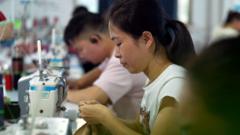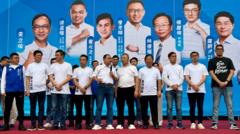Shein's success is built on a network of Chinese factories in Panyu, where workers endure grueling hours and low wages. Despite allegations of worker exploitation, the company continues to thrive, with plans for a potential public listing amidst calls for greater transparency in its supply chain.
Unveiling the Workforce Behind Shein's Rise: A Look into Panyu's Factories

Unveiling the Workforce Behind Shein's Rise: A Look into Panyu's Factories
A deep dive into the working conditions and labor dynamics of the factories powering Shein, the global fast fashion giant.
The sound of sewing machines fills the air in Guangzhou's Panyu district, dubbed the "Shein village," where thousands of workers churn out clothing for the world's largest fast fashion retailer. With production running from sunrise to past midnight, many employees report working up to 75 hours a week, far exceeding China's legal limits.
The BBC recently investigated the factories, interviewing numerous workers who typically receive one day off per month, with wages tied to the volume of clothing produced. For a t-shirt, workers earn less than a dollar per item. With the rising costs of living, workers are pushed to maximize output, leading to a continuous cycle of labor driven by Shein's demand for low-cost, rapid production.
Shein has grown exponentially in just five years, currently valued at about £54 billion ($66 billion), and is contemplating a listing on the London Stock Exchange. However, this rise has also brought scrutiny regarding the treatment of workers, with allegations of forced labor surfacing, and concerns about sourcing materials from the Xinjiang region linked to human rights abuses.
While Shein aims to present itself as committed to ethical labor practices, its statement about investing in supply chain governance is met with skepticism by rights groups. "The extreme form of exploitation needs visibility," states a representative from Public Eye, highlighting the deficient wages and excessive hours many workers face.
Despite the harsh conditions, some factory owners acknowledge that Shein's influence has transformed the industry landscape. They lament that while profit margins have shrunk under the weight of Shein's control over pricing, the scale of orders can bring significant revenue during peak times.
Amidst these dynamics, Panyu's factory workers maintain a sense of camaraderie, often likening their relationships with colleagues to family. As they continue to work late into the night on garments destined for consumers around the globe, the interplay between economic necessity and labor rights remains a pressing issue within the fast fashion ecosystem.
As Shein prepares for potential public scrutiny, experts emphasize that transparency in its supply chain is vital to rebuild trust and navigate the allegations threatening its reputation. Whether the retail giant can adapt its approach to labor standards amidst growth will determine its standing in an increasingly aware global market.
The BBC recently investigated the factories, interviewing numerous workers who typically receive one day off per month, with wages tied to the volume of clothing produced. For a t-shirt, workers earn less than a dollar per item. With the rising costs of living, workers are pushed to maximize output, leading to a continuous cycle of labor driven by Shein's demand for low-cost, rapid production.
Shein has grown exponentially in just five years, currently valued at about £54 billion ($66 billion), and is contemplating a listing on the London Stock Exchange. However, this rise has also brought scrutiny regarding the treatment of workers, with allegations of forced labor surfacing, and concerns about sourcing materials from the Xinjiang region linked to human rights abuses.
While Shein aims to present itself as committed to ethical labor practices, its statement about investing in supply chain governance is met with skepticism by rights groups. "The extreme form of exploitation needs visibility," states a representative from Public Eye, highlighting the deficient wages and excessive hours many workers face.
Despite the harsh conditions, some factory owners acknowledge that Shein's influence has transformed the industry landscape. They lament that while profit margins have shrunk under the weight of Shein's control over pricing, the scale of orders can bring significant revenue during peak times.
Amidst these dynamics, Panyu's factory workers maintain a sense of camaraderie, often likening their relationships with colleagues to family. As they continue to work late into the night on garments destined for consumers around the globe, the interplay between economic necessity and labor rights remains a pressing issue within the fast fashion ecosystem.
As Shein prepares for potential public scrutiny, experts emphasize that transparency in its supply chain is vital to rebuild trust and navigate the allegations threatening its reputation. Whether the retail giant can adapt its approach to labor standards amidst growth will determine its standing in an increasingly aware global market.




















